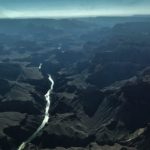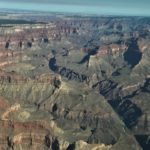Recently, Claudia planned an air route that would take us from KAEG airport in Albuquerque to Page, AZ and on to Sedona, AZ via the Grand Canyon. It’s a flight that we’ve dreamed of doing since we started working on our pilot certificates many years ago. The route would take us over some of the most spectacular terrain in the western USA.
Departing to the west, we climbed over the northern shoulder of Mt. Taylor. Then over a myriad unnamed ridges and rock formations until we passed north of Window Rock where we viewed the long morning shadows cast by the towering spires of sandstone rising up from the valley floor. Then over the top of Canyon de Chelly National Monument, deep in Navajo country where wind and rain have sculpted a work that stands up to the Grand Canyon in beauty though not in size. Next, more unnamed stretches of tortured rock as we passed south of Navajo Mountain, a geologically unusual and interesting piece of rock that marks the confluence of the San Juan and Colorado Rivers upstream of the Grand Canyon near Lake Powell. As we neared Page AZ, the lake came to a terminus at the Glen Canyon Dam which, from the air and amid the immense scenery around it, seemed so tiny that it could not possibly be holding back the massive lake. We then turned left into Marble Canyon , the gateway to the Grand Canyon. This is where we contacted LA Center (Air Traffic Control) and advised them of our passage through the “Big Crack” via the Dragon Corridor. Follow the Dragon Link to see the map of the flight corridors through the canyon. These flight rules ensure that the park remains peaceful and that pilots transit along consistent routes and altitudes to minimize disturbances to visitors and wildlife below. I can’t remember how long it took to cross the canyon but it seemed way too quick even though I slowed the plane as much as I could and still maintain the required altitude. We crossed the north rim south of Jacobs Lake and, with some trepidation, left the perceived security of the somewhat flat country that borders the canyon. Finding oneself out over that canyon rim in a small plane and experiencing the abyss below is a feeling hard to imagine until you do it. No emergency landing strips here!
Exiting the canyon, we were faced with Humphreys Peak just outside Flagstaff, AZ. We found a route over the west flank of the mountain, over I-40 and down into the red-rock rimmed valley where Sedona, AZ is located. What had been a tranquil flight suddenly became a busy puzzle negotiating mountains, other air traffic and unfamiliar winds to land on the mesa-top airport at Sedona. I’ll have to admit it was slightly stressful but we survived to have a wonderful brunch at the Mesa Grill airport cafe. Airport food is typically not the best but this one was one of the best we’ve experienced anywhere in our travels. That even includes restaurants in the big commercial airports.
Finally, we made the 2 hr flight back to Albuquerque while fighting updrafts and downdrafts all the way. We re-learned that flying at mid-day in the desert in the summer is not a great idea and may lead to feelings of discontent when executed immediately after eating a nice meal.
All in all, our visit to the Big Crack was all we had hoped it would be. We expected spectacular scenery at the crack but were pleasantly surprised by the other impressive locations along the route. All while covering scenery that people usually take many days or even weeks of vacation time to see – in about 6 hours.


